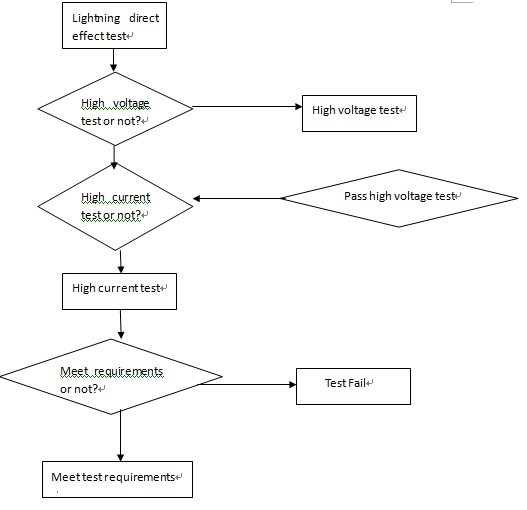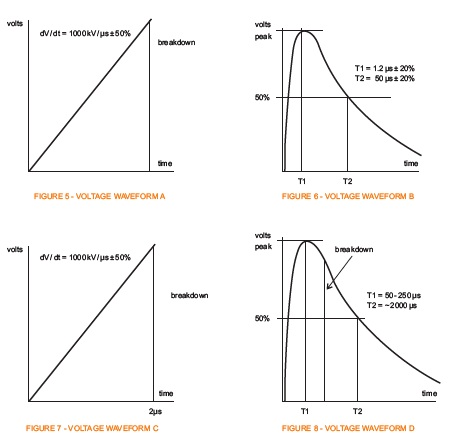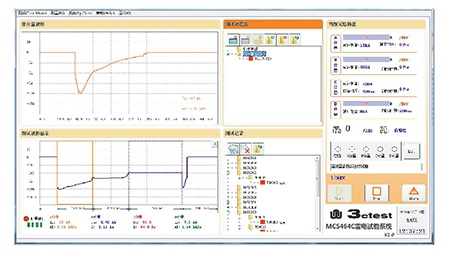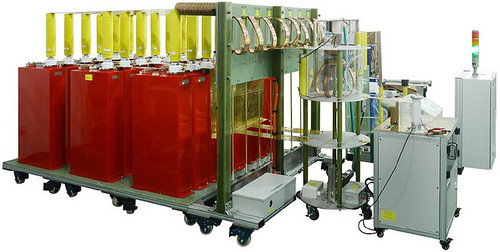Overview
Aircraft is vulnerable to lightening direct adhesion in severe convection weather, which will produce over temperature, high voltage and strong electromagnetic force to cause the aircraft to be on fire, corrosion, explosion, structure distortion and strength reduction, etc. The lightening direct effect test system our company independent research and develop is a very complicated pulse current test system, mainly used in lightening direct effect tests for system, components and materials as per national military standards like GJB1389A,GJB3567, also American military standards MIL-STD-464C, ARP5412 and DO160 section23, etc. This system can be used for aircraft, aerospace materials, naval ships, missile, military vehicles and radar.
This lightening direct effect test system includes high voltage attachment points partition test system and high current physical damage test system. High voltage attachment points partition test system can simulate the possibility that equipments like aircraft are lightening attacked in different areas on the surface of aircraft and find the attachment points which are vulnerable to lightening attack. High current physical damage test system can be used to simulate the damage effect of aircraft structure caused by the over temperature and strong electromagnetic force which are produced when the attachment points are suffered to high current.
Lightning Test Flow Chart
This system can be configured according to customers test requirements and provide full test solutions.

High Voltage Attachment Ppoints Partition Test System
This system is composed of three parts including high voltage generator, waveform regulation unit and control measurement system, four kinds of waveforms A, B, C, D are output by regulating different waveform regulation units, meet MIL-STD-464C , DO160 S23 and other standards about direct lightning high voltage test, also used for other similar lightning and withstand voltage tests and research.
Waveform Parameter Definition
According to MIL-STD-464C and SAE ARP5412, etc, four voltage waveforms shown as below:

Requirements:
A component rising slope: 1000?-0+50%?kV/μs, rising stop when test device breakdown or flashover and turn to zero. If no flashover for test device, there is no regulation for the waveform drop.
B component open circuit voltage waveform with rising slope: 1.2μs (±20%) and duration: 50μs?±20%?
C component the voltage waveform cut off at 1.2μs, no requirements for rise time and peak value.
D component open circuit voltage waveform with rising slope: 50-250μs and duration: ?2000μs. The waveform is used for testing the time characteristic, when the waveform is used for the analysis of lightning attachment area probability, the conclusion is higher than the actual value.
| SPECIFICATIONS | ||||
| Technical Parameters of LVG3000 | ||||
| Output waveform | A waveform | B waveform | C waveform | D waveform |
| Front time | 1000?+500?kV/μs | 1.2μs±20% | 2μs±20% | 50-250μs |
| Decay time | -- | 50±20% | -- | ??2000 |
| peak efficiency | ?90% | ?90% | ?80% | ?60% |
| Charging voltage | 200kV (two-side charging) | |||
| Levels | 15 | |||
| Discharging switch | copper ball , three-gap ignition | |||
| Switch type | linear driving 0?100mm adjustable, accuracy 0.1mm | |||
| Waveform shaping | Form a long wave tail by Crowbar feedback circuit | |||
| General Data | ||||
| Power supply | AC220V 100A | |||
| Charging voltage | 20?200kV | |||
| Polarity | +/- | |||
| Voltage measurement | Damped voltage divider | |||
| Features: | ||||
| • LVG 3000 with open style main circuit design and H shaped tower structure to achieve a compact size | ||||
| • Artistic and simple appearance | ||||
| • Parallel charging and series discharging by Max generator | ||||
| • Automatically adjust ball gap distance within the charging voltage, 0.1mm resolution adjustable | ||||
| • Automatic safety protection procedure, audible and visual alarm | ||||
High voltage attachment points partition test diagram:

(1)Max voltage generator
(2)Regulation waveform unit
(3)Measurement voltage divider
(4)Regulation waveform unit includes steep slope, chopped wave or operation wave
(5)Grounding plane
High current injection system
Aircraft is vulnerable to lightening direct adhesion in severe convection weather, which will produce over temperature, high voltage and strong electromagnetic force to cause the aircraft to be on fire, corrosion, explosion, structure distortion and strength reduction, etc. The aircraft lightning protection test system researched and developed independently by 3ctest is a very complicated pulse current test system, fully meets American military MIL-STD-464C, SAE ARP5412 and DO160 section23, the direct adhesion lightening area of the aircraft should bear the continuous waveforms composed of A, B, C and D, this system includes four pulse current generators.
- Six waveforms generated by four generators
- Charging polarity automatic switching by using rotating mechanism
- Electrical safety interlock, automatic short circuit capacitor and protect personal safety
- Non-gap Crowbar feedback circuit, waveform without oscillation
- Optical isolation of control signal between control and itself
- Every generator used independently with independent control system
- Many test modes can be programmed freely, meet kinds of test waveform requirements within test range
- Centralized control system can operate four generators and complete the test with one key
- High voltage switching by using multi-way air-operated units, waveforms switching over automatically
About Waveforms
Test waveforms include 6 waveforms: A, AH, B, C, C* and D, shown as below:

Component A: peak current 200kA±10%, action integral 2×106A2·s±20% (within 500μs), rise time (10%-90% before peak)≤50μs, decay to 1% of peak wave≤500μs. Current could be one-way or oscillatory.
Component AH: peak current 150kA±10%, action integral 0.8×106A2·s±20% (within 500μs), rise time (10%-90% before peak)≤37.5μs, decay to 1% of peak wave≤500μs. Current could be one-way or oscillatory.
Component B: current amplitude average 2kA±10%, max. electric charge?10C ± 10%, duration ≤5ms. Current could be one-way square wave or replaced by exponential current or linear decay current.
Component C: current amplitude 200-800A, electric charge 200C ± 20%, duration 0.25-1s. Current could be one-way square wave or replaced by exponential current or linear decay current.
Component C*: current amplitude average≥400A, duration = dwell time of combination wave -5ms. Duration of combination wave: 1-50ms. Current could be one-way square wave or replaced by exponential current or linear decay current.
Component D, peak current 100kA±10%, unidirectional current or oscillatory current, rise time (10%-90% before peak)≤25μs, decay to 1% of peak ≤500μs, action integral 0.25×106A2·s±20% (within 500μs).
MIL-464C/DO-160G Section 23 Aircraft lightning protection system configuration:
This lightning system includes 5 set control system, 1 set measurement analysis system, 4 generators used to produce four components A, B, C, D, communication among generators by industry field bus to achieve independent experiments for 4 generators and centralized total control function.
Generator A and D use non-gap self-adaption Crowbar units, for non-gap Crowbar switch, there is no need to trigger by impulse voltage generator, no need to ignite by secondary delay control, it is a real self-adaption trigger. For non-gap switch, the noise is reduced greatly and the output reliability of equipments is improved.







